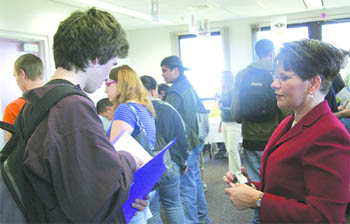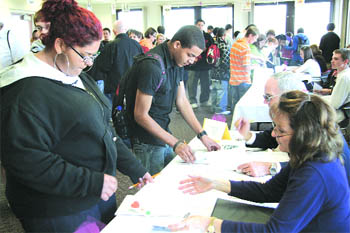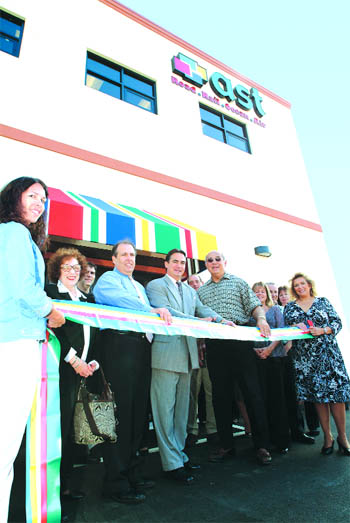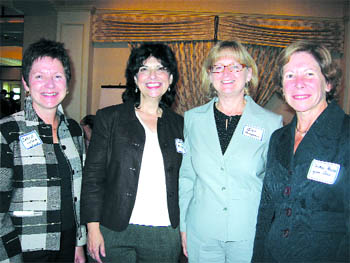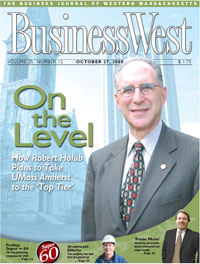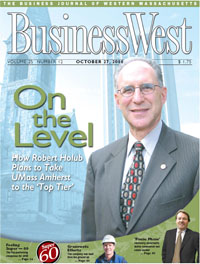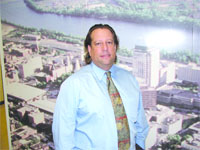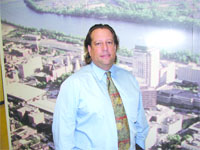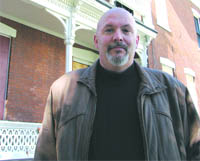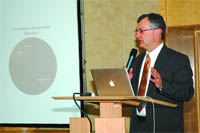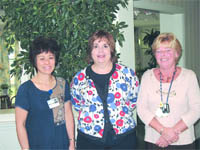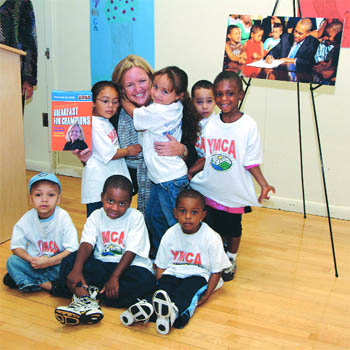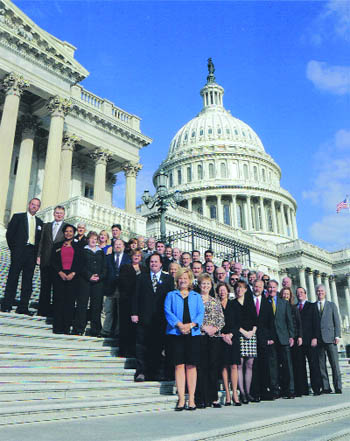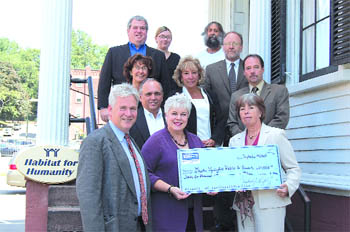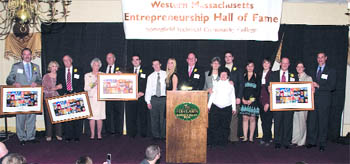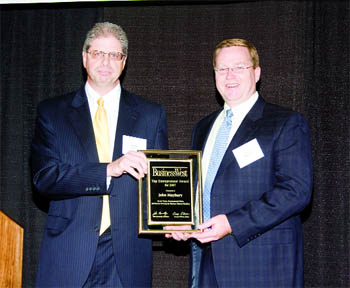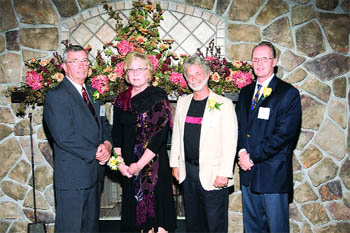Robert Holub says it was the first pragraph of the ad placed in a higher-education trade journal that caught and held his attention.
He doesnt recall the exact wording, but it was something to this effect: that the president and trustees at UMass Amherst were looking to recruit someone who could bring the campus into the top tier of public research universities in the country.
Only a few months before that ad was placed, Holub, then provost and vice chancellor for Academic Affairs at the University of Tennessee, wasnt looking for another job opportunity. But by the time it appeared, following some leadership changes in Knoxville and greater uncertainty about his future there, he was paying much closer attention to such postings.
He was aware of UMass and its national reputation like many others, he says the school is better-regarded outside the Bay State than within it and was intrigued. But it was the next-level nature of the assignment that also appealed to him. Many schools are looking to make such a jump, he told BusinessWest, and UMass has been for several decades now, it seems.
Indeed, such top-tier language is commonplace in ads posted by schools seeking a president or chancellor, he said, adding that this opportunity with its blend of timing, institution, and lingering historical challenge stood out in some ways and got him thinking about what might be the next line on his resume.
By midsummer, Holub, a German scholar, wasnt thinking about the UMass assignment any longer he was already hard at work on it, or at least laying the groundwork for it. And by September, when he arrived at the Amherst campus, he was talking to media outlets and other constituencies, including alumni, faculty, students, elected officials, and others, about just whats involved with taking such a school up a notch.
There is no manual and how-to guide for such work, he explained, adding that it comes down to making an across-the-board effort to improve everything from research to the volume of faculty awards; from endowment to the rankings in U.S. News & World Report and other publications.
And Holub has already taken some steps in these directions.
For example, he recently reinstituted the position of vice chancellor for Research, and expanded the title to include Engagement, in one of several organizational moves.
In examining the top public research institutions in the country, I have found very few that did not have a research office at the level of vice chancellor or vice president, he wrote to the campus community. If we are going to be among these top institutions, I believe it is wise to emulate their emphasis on research and research productivity.
Following, or attempting to follow, best practices established by the schools well ahead of UMass in the rankings will be part of the strategic plan for the university, said Holub. But such efforts dont take place in vacuums, and are inherently complicated by a number of factors, he said, putting everything from campus politics to simple economics on that list. And at the moment, state financing is a rather sore subject, with Question 1 (a proposed end to the Commonwealths income tax) hanging over every public institution, and $1 billion in cuts already made by the Patrick administration ($12 million at the Amherst campus).
But there are other factors, not the least of which is the fact that schools currently ranked higher than UMass in several of those categories have no intention of moving down the list.
They dont sit around and say, weve had our time in the top 25; lets give our spot to someone else, and the 20 schools in our position dont say, were happy where we are, Holub explained with a laugh, adding that reaching the next level certainly wont happen overnight.
In this issue, BusinessWest introduces Holub to the Western Mass. region and details (to the extent possible) his intentions and plans to take UMass Amherst where no one has.
School of Thought
As he talked with BusinessWest in his offices in the Whitmore administration building, Holub referenced a wall of framed photographs and architects renderings. Together, they convey more than a decades worth of expansion and new construction totaling hundreds of millions of dollars that crosses several schools and departments at the university.
The collection is impressive, and includes the integrated science building, the new Skinner Hall (home to the School of Nursing), the Isenberg School of Management, the recently opened integrated arts building, a recreational center currently under construction, the new, state-of-the-art central power plant, and many others.
But they will all be coming down soon.
These are things that are already done, for the most part, and achieved by the previous administration, said Holub. There are a host of new projects coming via the capital bond bill; we dont need to keep up the old ones.
Re-covering that wall with new building and expansion projects is just one of the official or unofficial goals that Holub has set since learning last summer that he had been the one chosen to take UMass to a higher tier and a new set of pictures will provide some evidence of progress in that regard.
But the real proof will come in the rankings, specifically those set by the National Research Council, or NRC, said Holub, who told BusinessWest that he wants UMass Amherst to join such schools as Michigan, Penn State, Berkeley, UCLA, and others among the top echelon of public universities.
Gauging the scope of the work ahead, Holub said that several UMass departments have already achieved top rankings from the NRC in terms of faculty awards, the school is in the top 20, for example but in others, the school is well down the lists.
Its a mixed bag, he explained. We do well in faculty awards, but in research, were down around 50 or so, and in endowment, were down below 100. We have some departments ranked in the top 20, and others that are unranked.
Questions about how to achieve across-the-board improvement no doubt dominated the interview process for the chancellors position, which Holub entered after nearly 30 years in higher education, 27 of them at Berkeley, which he placed in that top tier.
Holub started there as an undergraduate adviser in the German Department, and eventually became chair of that department and served in that post from 1991 to 1997. He would move up the ranks, and eventually be named dean of the undergraduate division of the College of Letters and Science, continuing a career-wide focus on undergraduate education. He left Berkeley for Tennessee and its chief academic post in 2006.
A change in leadership in Knoxville late in 2007 prompted him to start mulling career options, and he set his sights on a chancellors or presidents position.
What appealed to him about UMass was the solid foundation on which to build several academic programs are highly ranked and the professional challenge that awaited him at the school.
When asked where he starts, he said there will be several initiatives undertaken simultaneously, but research is obviously a top priority hence the launching of a national search for a vice chancellor of Research.
We have to improve in research productivity, in terms of federal research expenditures, he explained. Thats the way in which the top institutions are measured; we do well there, but dont do as well as the top tier.
The administrative change, with an emphasis on that word engagement that will now be in the title, is a key first step in this initiative, he continued. The research office should be able to act more effectively to assist faculty in doing their research, getting out research grants, and working with industry inside the state and outside it to attract research dollars.
Another priority is communication, he said, meaning both the internal and external varieties.
We have to make it known what is going on here, and what is so positive about whats going on here, he explained, noting that the accomplishments of the faculty are not as known and understood as they should be, for example. Many of the surveys that you have, whether its the National Research Council or US News and World Report, are reputational in nature, and in the past, I dont think weve done a good-enough job of communicating the excellent work that goes on here and the great research and teaching that are accomplished on this campus.
To achieve improvement, Holub has appointed Tom Milligan to the position of executive vice chancellor for University Relations, and has moved several units and individuals under this unit to ensure a more consistent and coordinated approach in reaching and engaging our key constituents, as the chancellor wrote in his E-mail to the campus community.
Milligan is putting together a more-cohesive communications strategy for the campus, Holub continued, adding that several departments at the school have been handling what amounts to public relations, but these have lacked coordination.
Textbook Examples
While discussing what it will take to move UMass up in the rankings, Holub addressed some of the theories offered as to why the school isnt on a higher tier, and why some question whether it can get there.
The proliferation of quality private schools in the Bay State is often mentioned in this discussion, because of how those schools Harvard, MIT, Wellesley, Amherst, Smith, and Mount Holyoke, among seemingly countless others compete with the state university for students, faculty, and the attention of the press, especially the Boston newspapers that cover Harvard like a blanket.
Meanwhile, distance from Boston is sometimes listed as a factor by those who believe Amherst is perhaps too remote to gain consistent attention from the Boston media, or to attract faculty and graduate students.
Holub acknowledged these contentions, but quickly discounted most all of them simply by showing what other schools facing similar issues and challenges have done.
Champagne, home to the Univerity of Illinois, is hundreds of miles of Chicago, he explained, and the Windy City has a number of top-tier private schools. But neither of those factors has kept the state university from reaching the place where UMass wants to be.
Meanwhile, he said, students dont usually choose between Harvard and UMass, or MIT and UMass the university traditionally faces different forms of competition for students. And as for the press, Holub took the attitude that, while the university can and will work harder to draw attention to itself as he outlined above he believes that if UMass can generate the kind of news hes looking for (not students getting arrested after Red Sox playoff games), then the media will cover it.
So the task at hand is to create such news or more of it.
Doing so amounts to a process, said Holub, adding that, for the past few months, hes been engaged in what might be considered the first step: listening.
Hes done a lot of it, while sitting across the desk from or standing at podiums in front of individuals and groups ranging from Allan Blair, president of the Economic Development Council of Western Mass., to distinguished alumni; from elected leaders in Boston and Washington to the schools foundation board; from every dean on the campus to some current students.
What is he hearing from them? Many things, he said, but one common thread is the need to move quickly and decisively to restore a sense of stability, something that is lost, or perceived to be lost, when a school like UMass loses as many top administrators as it has over the past several months.
What is Holub telling those groups and individuals? Essentially, that he wants to take those departments not ranked among the countrys elite and elevate them there, while taking those with high rankings and pushing them higher still.
Were the best public research university in New England, he said, stating with no lack of confidence in his voice that the school tops UConn in that category. But we cant be satisfied with that; we want to be one of the best in the country.
Overall dissatisfaction with the status quo is what Holub says brought him to UMass.
If they had said that they were satisfied with the way things were going and that they wanted someone to keep operating in that way, I wouldnt have been interested in the position, he said, referring back to that job posting. This university has achieved some great things, but it can do more and be more.
By the Book
When asked if there were any often-cited examples of schools reaching that next tier that he would attempt to emulate in some way, Holub said there are several, but that each story is different is some ways.
The common thread is achieving a campus-wide commitment to excellence, and not allowing standards or performance to slip.
Thats why schools that are that top-echelon usually stay there, he continued, adding that UMass wont easily take another universitys slot among the elite.
Every public university thats in the top 25 wants to stay in the top 25, and everyone whos 25 to 50 wants to get in the top 25, he explained. So, its a very hard competition.
Thus, UMass will have to earn its way to the top echelon, and the processing of doing so is already underway.
George OBrien can be reached at[email protected]

